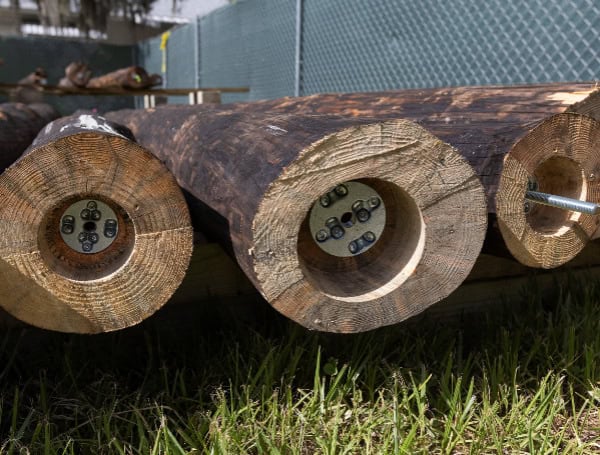
On a campus known for its stately brick buildings, the University of Florida’s newest structure stands out: a 400-square foot pavilion with timber columns, some straight, others erected at an angle. Holes allow light – and water – to stream through the roof and touch the ground, a combination of pine straw and coconut mat.
After months of planning, the UF/IFAS School of Forest, Fisheries & Geomatics Sciences (SFFGS) removed the fence encircling a patch of grass east of the Constans Theatre on Friday and revealed the MASS Haptic pavilion to the public.
“The pavilion is available for anybody to use as an outdoor lecture space or for a small group reception,” said Scott Sager, forester and coordinator of SFFGS undergraduate programs. “It could also act as a meeting point.”
Read: Agricultural Safety Center, UF/IFAS Release Heat-Related Illness Toolkit

The project is meant to promote sustainable construction using renewable, locally grown wood. The 28 pine logs that make up the column structure were harvested 7 miles away, in UF’s Austin Cary Forest. The roof consists of two cross-laminated timber panels manufactured with wood from the Florida panhandle.
“The pavilion demonstrates the strength of the Florida mass timber supply chain,” said Craig Vincent, vice president of operations for Walbridge, the Detroit-based construction company that served as the general contractor on the project. “Mass timber can reduce carbon emissions in the built environment by up to 70% and can transform the construction industry into a carbon storage system.”
Read: 2024 Winner Of Agricultural-Environmental Leadership Award In Florida Announced
Additional collaborators on the project include the USDA Forest Service Wood Innovation Grant program, the Softwood Lumber Board, Rex Lumber, Minimal Impact Engineering, Rothoblaas and Atelier Mey, a Miami-based architecture firm.
Each feature Atelier Mey incorporated has meaning.
The layout of the log columns reflects a typical planting regime of a working southern yellow pine forest with the holes in the roof representing trees that would have decayed during their growth process, said Chris Meyer, founding principal at Atelier Mey.
“The charring of the logs is an homage to the state of Florida — particularly the University of Florida — as acting as a leader in prescribed burning,” he said.
Atelier Mey founding principal Shawna Meyer said she hopes the structure emphasizes wood construction’s ability to promote regional materials that are renewable and generate a smaller carbon footprint than construction with mined or refined materials. “The more we use wood in building, the more demand we create for trees instead of seeing them disappear into another crop or into developed land,” she said. “I think there couldn’t be a stronger location than the University of Florida to talk about this story and a better project team to bring it to fruition.”
Help support the Tampa Free Press by making any small donation by clicking here.
Android Users, Click To Download The Tampa Free Press App And Never Miss A Story. Follow Us On Facebook and Twitter. Sign up for our free newsletter.


